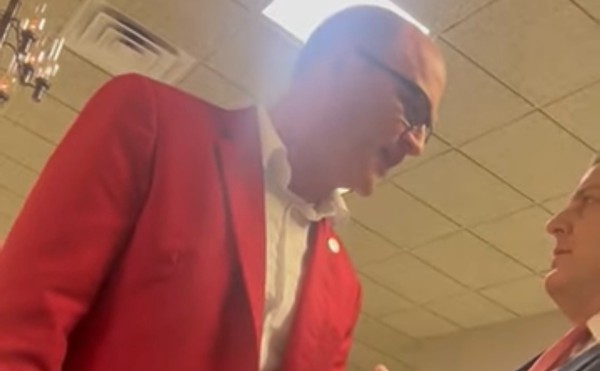He worked for 30 years at CertainTeed, a now-closed cement-pipe plant in North County, amid clouds of asbestos fibers. In the early '70s, he learned of a spot on his lungs -- asbestosis was what the plant's doctor called it -- but the pulmonary diseases that ravaged so many of his co-workers left Louis alone. Unlike them, he never needed an oxygen tank; indeed, he couldn't remember ever having trouble catching his breath.
Louis was luckier than other CertainTeed employees, many of whom ended their lives in excruciating pain, wasting away from asbestos-related illnesses -- workers such as Al Wiese, who spent his last days popping dozens of pills to control his blood pressure. The retired foreman's heart had enlarged to compensate for badly scarred lungs; his out-of-control blood pressure caused frequent nosebleeds so severe he'd wake up soaked in blood.
Of the 300-or-so men Louis knew at CertainTeed, he estimates that "at least 250," like Wiese, have died from asbestos-related illnesses, including asbestosis, lung cancer and mesothelioma, a virulent cancer of the lining of the lungs. An exact number of fatalities could not be verified, but study after study of asbestos in the workplace shows how deadly exposure can be. The diseases aren't always swift killers: They can take twenty to 40 years to show up, meaning that for people like Louis, who retired in 1981, the fear never goes away.
Louis went for a routine chest X-ray and physical in December. Unlike previous visits, the doctors ordered additional tests and an examination by a heart-and-lung specialist. When he was interviewed in January, the 79-year-old was worried: "I've been really thinking about it."
In 1982, Dr. Irving J. Selikoff, the nation's top expert on asbestos epidemiology, predicted that lung cancers and mesotheliomas among asbestos workers would peak between 1998 and 2002 and that asbestos-related cancers would be part of the national landscape until 2037. Selikoff's predictions have proved to be on target, judging from the asbestos litigation that's flooded the nation's courts for the past two decades.
When their claims were first filed, workers who were dying and workers who didn't have any symptoms were part of large settlements. Back then, workers who were sick outnumbered people who were asymptomatic.
That's changed.
Now, more cases are being brought by people who, unlike Harold Louis, never directly worked with asbestos. These new litigants were "bystanders," people who contend that their exposures came from family members or industrial pollution. For-profit screening companies, testing workers and signing them up for lawsuits, have also caused a jump in the number of cases in which plaintiffs claim they've been exposed to asbestos but show no symptoms.
For twelve years, St. Louis Circuit Court handled asbestos-related lawsuits with a special docket designed to move cases along quickly. But with the shift in the types of cases, one local judge says it's time to stop giving asbestos cases special treatment. Circuit Judge Robert Dierker is proposing to eliminate the docket he now oversees -- a move that's drawing fire from defense and plaintiffs' lawyers. They say Dierker's move could throw the case-management system into chaos, meaning it may take longer to get some cases to trial and cause big scheduling headaches for the companies that must fight these cases not just in St. Louis but across the nation.
They're also certain that Dierker's proposal won't do anything to discourage people from filing cases about a problem that has cast a wider net than even Selikoff predicted.
At first, the asbestos docket was a good idea. A single case can have 80 to 100 plaintiffs and dozens of defendants. "When we started the docket, the overwhelming majority of the plaintiffs were construction-industry exposures," Dierker says. "I would say the majority were insulation workers or pipefitters, people who had undoubted direct exposure to readily identifiable products."
The special docket meant that pretrial rulings were consistent; it was like having the same umpire calling the strikes for every game during the baseball season. The possibility that opposite rulings would be handed down by two different judges sitting in the same courthouse were minimized. It also removed some of the trial-date guesswork, which is one of the biggest advantages for companies that always have a number of cases pending on a nationwide scale and for plaintiffs' lawyers who've embraced the niche practice of asbestos litigation.
But Dierker says the court-created efficiencies may have had some unintended consequences: "I suspect, but I couldn't prove it, that we may be a victim of our own success."
The industrial-exposure cases that wound up on the city's docket initially were mainly asbestosis claims, but, Dierker says, "Asbestosis claims, I think, have virtually disappeared."
That's because asbestosis is a disease that is usually seen in cases of prolonged exposure to asbestos -- years of working five days a week in an environment packed with asbestos dust. But by 1979, the EPA had finally limited the amount of floating asbestos particles workers could be exposed to, many of the asbestos-cement plants had closed down or moved overseas and the construction industry had reduced its reliance on asbestos-containing materials.
Although asbestosis claims may be waning, other kinds of cases are popping up in the breach. "There was an evolution of the type of claims so that we were getting more and more of what I call 'bystander' or 'secondary exposure' cases," Dierker says, "and it became harder -- is the best way to put it -- to establish the nature of the claims and the identity of the defendants."
Often these are cases like the ones involving Mary Samsel and Sandra Vierdag, women who grew up near the old CertainTeed plant and large asbestos-waste dump along the banks of Maline Creek [Dreiling, "Left Behind," January 8]. Samsel contracted lung cancer and sued CertainTeed, along with many other companies that were later dropped from the case. Vierdag died of mesothelioma. Her husband has sued CertainTeed, as well as several other companies.
Another kind of secondary case is those involving the spouses of asbestos workers, often women who washed their husband's dusty, asbestos-laden clothes week after week and wound up with cancer.
Dierker says that most of the cases he's seeing on his docket are asymptomatic, ones that are "packaged in large numbers so that they generate, you know, a substantial fee but, perhaps, modest compensation to the plaintiff.'
In fact, he says, most cases that have been settled or tried in the past two years have involved plaintiffs with no symptoms. Because the nature of the cases has changed over the past decade, he says the court shouldn't give the cases preferential treatment and thereby reinforce the idea that the city will get asymptomatic cases resolved quickly.
But the lawyers who represent both companies and plaintiffs have asked Presiding Judge Michael David to reject Dierker's recommendation.
"It will end up being a mess," says Randy Gori, a plaintiff's attorney from Edwardsville. In addition to worrying about trial settings, he says, "the quicker we can get the cases to the courthouse," the greater the likelihood they [plaintiffs] can avoid companies' "seeking protection in bankruptcy court."
Kent Plotner, an Illinois defense attorney who represents CertainTeed, agrees. "The difficult thing about this litigation is, it is more on a national basis, so when you have given dates and given time periods," he says, it is easier for the clients. "Otherwise, you never know whether you're rolling."
Andrew O'Brien, a St. Louis plaintiff's attorney, says it's wrong to blame the number of filings on the special docket: "It is not set up to attract cases -- it efficiently manages them."
The real reason for all the cases is simple, he says: Asbestos exposure was more widespread than anyone anticipated.
Harold Louis' world doesn't revolve around lawyers or courtroom procedure or docket management. He's worried about how much time he has left, how long his health will hold up.
It's not the first time Louis has tangoed with the Reaper. In World War II, he was in a tank battalion, fought in the Ardennes, Alsace, Rhineland and Central Europe.
One early morning in December 1944, while he was serving outpost guard duty, he heard a V-1, a German flying bomb. "As long as that thing kept running, it was a putt-putt; you knew you was safe," Louis says. "And this morning, the putt-putt stopped. Of course, you didn't know where it was, but I did -- after I went about twenty feet in the air." He came back to earth, recovered, was awarded a Purple Heart.
After the war, he returned to his wife, Ruth, and his factory job at the Keasbey & Mattison asbestos-pipe-and-shingle plant near Bellefontaine Neighbors and Riverview. In the '50s, he became a tool-grinder at the company's cement-pipe operation.
Though the work was dry and dusty, he didn't wear a respirator. "We didn't know how serious this thing was back then," Louis says. The asbestos waste the plant produced, Louis says, was "put out into the dump -- the creek that went down between the two plants." The plant didn't have an exhaust system to keep fibers from being inhaled. "They had a few fans up in the fiber room, but as far as the rest of the plant, it was just opening up the windows."
Workers were getting sick, but, Louis says, "We didn't know what it was."
In 1962, Keasbey & Mattison became CertainTeed. That was about the same time Louis was elected president of the United Cement, Lime & Gypsum Workers Local 36. After retiring, Louis worked for several years as an international representative for his union.
Now he spends a lot of his time attending funerals for his former co-workers.
Last year, Louis lost Ruth, his wife of 58 years. The couple went to Saturday-evening Mass and then out to dinner. As they were getting ready to leave the restaurant, Ruth slumped over, unconscious. Heart problems, Louis says. The next morning, Ruth was alert, awake and sitting up in her hospital bed. Though she was hooked up to a respirator in the intensive-care unit, she was able to say goodbye to her husband, their two grown children and other family and friends before dying on Sunday evening.
"That's the way to go," Louis says. "No suffering."
Unfortunately, he isn't facing the same future. On February 28, he was told he has lung cancer.





